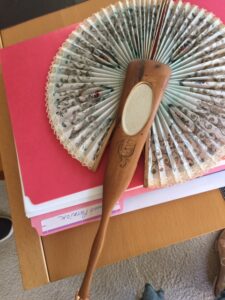 GK invited me over to look at her vintage fan in perfect condition, a souvenir of an event, perhaps a fair, in the first quarter of the 20th century. But the history of the art form called the fan starts in ancient history, about 2,000 years or more ago. Because the fan moves the stuff of life, air, over the years, the fan took on symbolic proportions.
GK invited me over to look at her vintage fan in perfect condition, a souvenir of an event, perhaps a fair, in the first quarter of the 20th century. But the history of the art form called the fan starts in ancient history, about 2,000 years or more ago. Because the fan moves the stuff of life, air, over the years, the fan took on symbolic proportions.
The English word FAN derives from the Chinese character word SHAN, a tool used in that culture since AD 121. China has the longest record of accomplishments in using and making fans in the world.
A second Century AD Chinese dictionary defines the word Shan as the architectural feature attached to the indoor ceiling with access to air from a door or window. Meaning a large ceiling fan mounted on a pulley system that one’s servants operated. The servant pulled back and forth on a ropes attached to a piece of fabric adorned with feathers. What better material to move the air? Such fans became, in the highest rank of homes, a symbol of prestige. In the house of a commoner one found a fan made of goose feathers. In the house of an official, one saw a fan of pheasant or peacock feathers. Thus, fans became synonymous with rank.
Handheld Fans
The idea of a handheld fan folded, and whipped out for heat deflection and bugs thwarting, originated in Japan in the twelfth century when an artist observed the bat wings. However Asians used flat fans as personal cooling devices for about 1,000 years. These also became a symbol of rank, and therefore decorated with the THREE EXCELLENCES: poetry, calligraphy, and painting.
Other cultures created handheld fans. None other than Columbus brought back six fans to the Spanish Crown from the Americas. Specifically from the Aztec people, who assigned him the task of presenting their fans to Ferdinand and Isabella.
Egyptians made flat handheld fans out of metal or fabric. For the nobility they used ostrich feathers, synonymous with a reference to the god of the determination of the soul’s worth, MAAT. He’s portrayed in myth as a bird.
Fans held symbolic content for thousands of years in many cultures
The American South adopted the Chinese version of the ceiling fan in Southern Architecture in the 19th Century. They called these fans by the Chinese name, but anglicized, Chuke fans. A measure of status, one’s servants cooled off the room. Those came with two hefty strings attached to two boards on a lever system, and two servants pulled to get the desired cooling effect.
On the other hand, literally, a handheld decorated fan was recorded as early as 33 BCE in China. Some came decorated with a poem or painting, or calligraphy, but the best showed all Three Excellencies.
By the time the Japanese folding fan made its way to China in the Sung dynasty (960-1279) we see the same form of GS’s. These paper folding fan on a wooden stick refolded for storage, and came painted and decorated. They called this form a Wo-Shan.
Surprisingly, Asian families changed out their relative’s fan’s papers, and kept the delicate ribs. Thus, it was not the decorations on paper that were venerated, but the ribs. The ribs were considered a family treasure, perhaps for the fine engineering involved.
In the 18th and 19th century Asia and Europe exported highly desirable fans, often painted in the Western Taste. This meant these fans were not abstract, did not contain calligraphy, or Chinese poems. But the new Chinese Republic banished these fans as exports to the West at the turn of the 20th century.
GS’s fan dates from the early 20h century when American manufacturers saw the profitability of paper and simple wood to create such souvenirs. I’ve seen many as emblazoned with certain world’s fair emblems from this period. GK’s is a delightful symbol of the lingering appeal of the fan, and hers is in perfect condition.
The value of GK’s fan is $150.